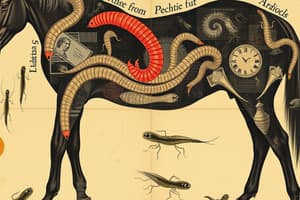Podcast
Questions and Answers
What is the definition of helminths?
What is the definition of helminths?
- Bacteria
- Parasitic worms (correct)
- Single-celled organisms
- Fungi
What are tapeworms classified as?
What are tapeworms classified as?
Cestodes
What characteristic defines flukes?
What characteristic defines flukes?
Flat ovoid bodies
What type of worm is Ascaris lumbricoides?
What type of worm is Ascaris lumbricoides?
How do humans become infected with Ascaris lumbricoides?
How do humans become infected with Ascaris lumbricoides?
What is the complete life cycle of Trichinella spiralis?
What is the complete life cycle of Trichinella spiralis?
What is the main characteristic of schistosoma mansoni?
What is the main characteristic of schistosoma mansoni?
What are the major classes of helminths?
What are the major classes of helminths?
Flashcards are hidden until you start studying
Study Notes
Helminths Overview
- Helminths are multicellular parasitic worms with developed organ systems, primarily focusing on reproduction.
- Major classes include tapeworms (cestodes), flukes (trematodes), and roundworms (nematodes).
Tapeworms (Cestodes)
- Characterized by long, flat, ribbon-like bodies.
- Infest the intestines of vertebrates, leading to nutrition absorption from the host.
Flukes (Trematodes)
- Possess flat, ovoid bodies.
- Often associated with liver and respiratory conditions in hosts.
Ascaris lumbricoides (Roundworm)
- Nematode with complete digestive system and two separate sexes.
- Infection occurs via eggs or larvae, migrating through the human body from the intestines to the lungs and back.
Necator americanus (Hookworm)
- A type of nematode, known to cause anemia in human hosts through blood-sucking in the intestines.
Taenia solium (Pork Tapeworm)
- Causes cysticercosis in humans and pigs through egg ingestion from fecal contamination.
- Infections can affect the nervous system and musculoskeletal issues in severe cases.
Echinococcus granulosus
- Adult resides in the small intestine, with eggs passed through feces.
- Intermediate hosts can develop cysts in organs, leading to serious health issues.
Enterobius vermicularis (Pinworm)
- Common nematode affecting children, causing itching and discomfort in the anal region.
Clonorchis sinensis (Chinese Liver Fluke)
- Associated with biliary tract diseases.
- Can lead to cholangiocarcinoma through chronic infections.
Trichuris trichiura (Whipworm)
- Associated with severe dysentery, anemia, and developmental issues in children.
- Known to impact cognitive function and physical health.
Trichinella spiralis (Larval Stage in Tissue)
- Nematode with a direct life cycle, completing development in one host.
- Prominent infection source is undercooked pork, leading to intestinal and muscle complications.
Schistosoma mansoni
- Uniquely dioecious (having male and female sexes) and resides in the host's blood vessels.
- Causes schistosomiasis with various systemic implications.
Platyhelminths (Flatworms)
- Class includes flatworms like acanthocephalins (thorny-headed worms), cestodes (tapeworms), and trematodes (flukes).
Acanthocephalins (Thorny-headed Worms)
- Parasitic worms known for thorn-like structures on their heads, adapting for attachment to host intestines.
Distinctions of Helminth Classes
- Cestodes: Tapeworms with segments.
- Trematodes: Flukes with leaf-like morphology.
- Nematodes: Roundworms with cylindrical bodies and a complete digestive tract.
Studying That Suits You
Use AI to generate personalized quizzes and flashcards to suit your learning preferences.




